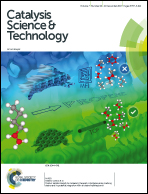How and why a [Bu4P][Im]/CO2 system efficiently catalyzes the hydration of propargylic alcohols to α-hydroxy ketones: electrostatically controlled reactivity†
Abstract
Density functional theory calculations have been performed to understand the intriguing experimental observations on the hydration of propargylic alcohols to α-hydroxy ketones catalyzed by task-specific ionic liquids (ILs) and CO2. Focusing on a representative propargylic alcohol, 2-methylbut-3-yn-2-ol, we explored its hydration mechanism and the catalytic reactivities of different ILs towards the reaction in detail. The calculated results show the electrostatically controlled character of the reaction, where the reactivity depends on not only the anion's own nature but also its counterion cation that can regulate and control the anion basicity via electrostatic and H-bonding interactions. The reaction is proposed to proceed via an energetically viable mechanism that features the initial addition of CO2 to the hydroxyl group of the propargylic alcohol with assistance of the IL anion as a proton acceptor. The different catalytic performances of several ILs are attributed to their different proton-accepting capabilities. The best catalytic performance of [Bu4P][Im] is ascribed to its most efficient proton-accepting properties. The theoretical results provide a foundation for exploiting the controlled synthesis of α-hydroxy ketones as well as cyclic carbonates and oxazolidinones from the hydration of propargylic alcohols or propargylic amines.
![Graphical abstract: How and why a [Bu4P][Im]/CO2 system efficiently catalyzes the hydration of propargylic alcohols to α-hydroxy ketones: electrostatically controlled reactivity](/en/Image/Get?imageInfo.ImageType=GA&imageInfo.ImageIdentifier.ManuscriptID=C7CY01646H&imageInfo.ImageIdentifier.Year=2017)


 Please wait while we load your content...
Please wait while we load your content...